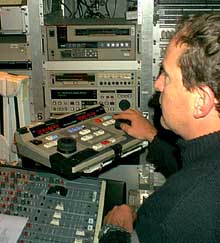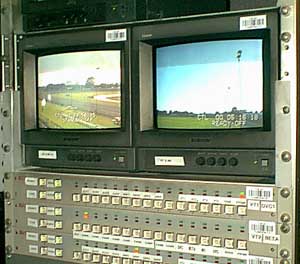Slow Motion Replays
 VT (Videotape) Operator
VT (Videotape) OperatorThe two tape machines in the background are used for slow-motion replays. In this case the operator uses the edit controller to adjust the tape speed.
"Slo-mo" replays are an integral part of television genres such as sports and other action programming. There are two main ways to create the slow motion effect:
- Record the action on a tape or disk, then re-cue the shot (i.e. rewind to the start point) and play it back at less than full speed. This is the preferred method for live broadcasts (when the replay immediately follows the live action) and is the method covered on this page.
- Reduce the speed of a shot in post-production (editing). Although the exact procedure will vary depending on the hardware and software you use, it's relatively straightforward process and once you've done it a few times you'll be able to easily adapt to other systems. See slow motion in Adobe Premiere for an example.
 Hard-Disk Recorders
Hard-Disk RecordersModern replay systems use computers rather than tape-based recording systems.
Slo-Mo Replays in Live Broadcasts
One of the many jobs in a live broadcast environment is the VT (Video Tape) operator. There may be more than one VT operator, in fact larger productions have entire rooms dedicated to VT stations, often with their own VT director.
Note that the term "VT" is becoming something of a legacy title, since much of this work now uses computer systems rather than tapes. However the basic functions are still the same.
Examples of VT operations include:
- Recording shots from various cameras and other sources, either for immediate replay or later editing.
- Assembling and editing shots, interviews, etc.
- Playing pre-recorded or edited material at the appropriate time.
In theory, playing a replay is a simple thing to do. We'll use the example of a simple football game broadcast In which there is one VT operator and two VT machines (called VT-A and VT-B).
 Monitors and Input Selectors
Monitors and Input SelectorsThe VT operator uses two monitors to view the output of her machines. Below the monitors, selectors allow the operator to choose which camera (or other source) to record.
Each VT machine is capable of recording any of the cameras covering the game. The VT operator selects a particular camera to record on each machine - this is independent of what is happening on the main programme. Each machine may record one camera exclusively, or may chop and change cameras depending on where the action is happening. In our example, VT-A records a single camera on a wide shot for the entire game, VT-B alternates between two cameras at each end of the field.
Let's say one team scores a touchdown. This is the sequence of events:
- The operator sees that the team is heading toward the opposition score line, so she selects the camera at that end of the field on VT-B (remember that VT-A is always recording the wide shot).
- After the touchdown is scored, the operator keeps recording long enough to capture some reaction from the scoring player.
- The operator re-cues both VT machines to the start of the last phase of play leading up to the touchdown, and then waits for instructions from the director.
- The director instructs the operator to play the replay on VT-A (he will say something like "Roll A").
- The VT operator plays the replay on VT-A in slow motion (eg. half speed). As the replay progresses the operator might slow the speed further and finally freeze the tape at an appropriate point.
- The director instructs the operator to play the replay on VT-B.
- The VT operator repeats the process with VT-B.
In this way, the touchdown is immediately followed by two action replays; the first from the wide shot and the second from the end-on camera.
Things for the VT operator to consider:
- Your job will be a lot easier if you have a good understanding of the subject you're covering. For example, you need to know which parts of the football game are interesting to the audience. Often your director will ask you to re-cue at a certain point in the play and you'll need to know what he means. You may also be asked to look for interesting things to replay and offer suggestions to the director.
- Most slo-mos look better if the camera has some shutter, usually betwwen 1/60 and 1/500 sec. This makes individual frames sharper, the action easier to see and the final freeze nice and clear.
- Watch the action closely at all times and be aware of what you're recording. When you are preparing a replay you need to know exactly how it unfolds - if the camera loses focus halfway through the replay you need to know (and tell the director) before you play it.
- If you're going to freeze the replay at the end, try to plan a good frame. For example, a shot of the football player's hand going up in a victory salute.
- As with anything in television production, the exact methods used for slow-motion replays will vary between production companies. Although the example above is fairly standard, you need to familiarise yourself with the way things are done in each situation you encounter. For example, exactly what commands does the director use? What settings and speeds are you expected to use? How much autonomy do you have to make replay decisions?
VT and replay operators are expected to think and act quickly and decisively. If you're working in live television there is little time to ponder. Make sure you are confident about what you're doing and what is expected of you. As always, if you're not sure about anything - ask!
Ralated Information: